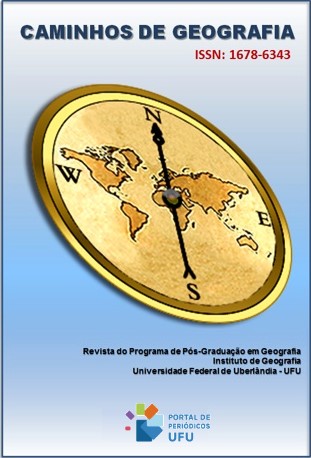(DES)CONECTIVIDADE HIDROLÓGICA AO LONGO DO PERFIL LONGITUDINAL DO RIO DUAS BOCAS (ES)
DOI:
https://doi.org/10.14393/RCG249465806Palavras-chave:
Bacia Hidrográfica, Conectividade, Sedimentos, Nutrientes, Uso e cobertura da terraResumo
A conectividade hidrológica é uma abordagem teórica que investiga os fluxos de energia e matéria nas bacias hidrográficas. Este estudo tem por objetivo analisar a (des)conectividade hidrológica em relação aos diferentes usos e coberturas terra, bem como o efeito da barragem de Duas Bocas ao longo do perfil longitudinal do Rio Duas Bocas (Grande Vitória, ES). Entre agosto de 2016 e 2017, foram coletadas amostras de água fluvial para análise de nitrogênio total, fósforo total e concentrações de sedimentos em suspensão (Css), além de medições de fluxo, em quatro estações de amostrais ao longo da bacia (82,8 km2). O uso e cobertura da terra das áreas de contribuição efetiva foram obtidos do ortofotomosaico de 2012/2015. Os resultados mostram que a cobertura florestal é essencial para reduzir a concentração de nutrientes e Css na estação DB01 a montante do reservatório. A barragem de Duas Bocas fragmenta a hidrologia longitudinal, afetando principalmente a estação DB02 localizada a jusante da represa. As maiores concentrações de nutrientes e sedimentos suspensos indicam a conectividade hidrológica longitudinal do rio com o uso da pastagem e da terra agrícola. A conectividade hidrológica evidencia a importância da análise dos fluxos de energia e matéria em bacias hidrográficas.
Downloads
Downloads
Publicado
Edição
Seção
Licença
Copyright (c) 2023 Fernando Henrique Lemos, Alanderson Gomes de Souza, Gilberto Fonseca Barroso, Eberval Marchioro

Este trabalho está licenciado sob uma licença Creative Commons Attribution-NonCommercial-NoDerivatives 4.0 International License.
Autores que publicam nesta revista concordam com os seguintes termos: a) Autores mantém os direitos autorais e concedem à revista o direito de primeira publicação, com o trabalho licenciado sob a Creative Commons Atribuição-NãoComercial-SemDerivações 4.0 Internacional. b) Autores têm permissão e são estimulados a publicar e distribuir seu trabalho online (ex.: em repositórios institucionais ou na sua página pessoal), já que isso pode gerar alterações produtivas, bem como aumentar o impacto e a citação do trabalho publicado. c) Em virtude de aparecerem nesta revista de acesso público, os artigos são de uso gratuito, com atribuições próprias, em aplicações educacionais e não-comerciais.











